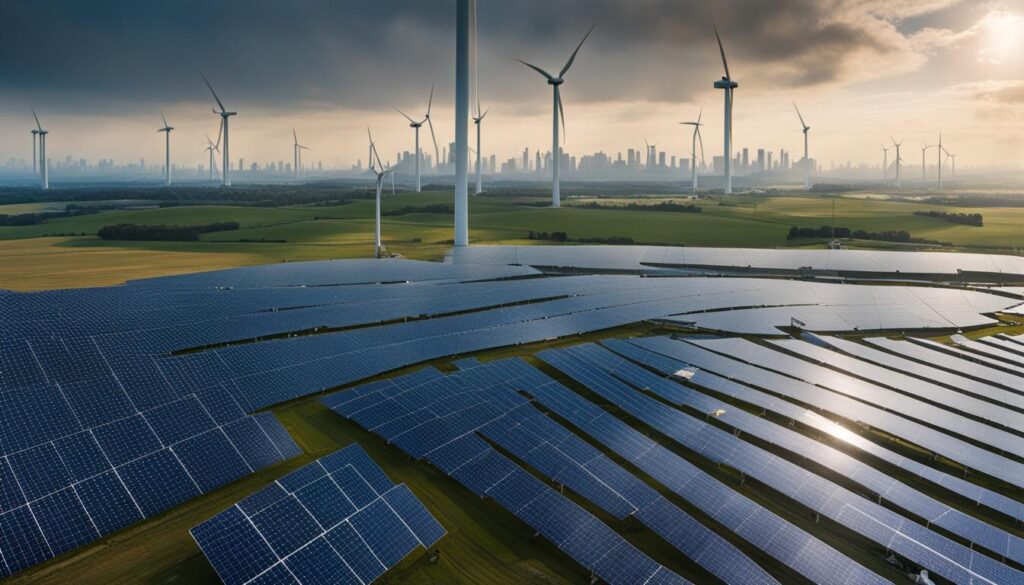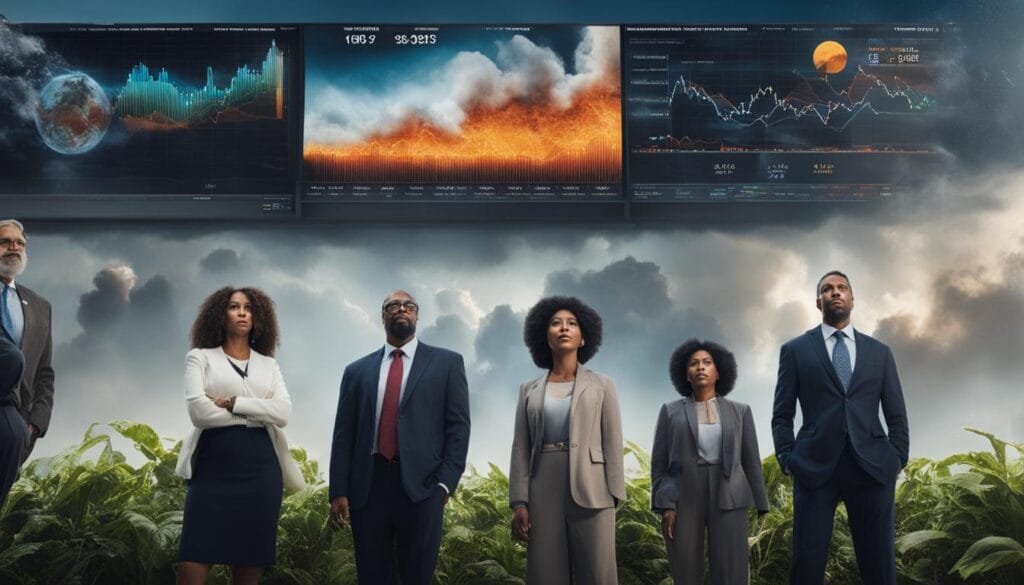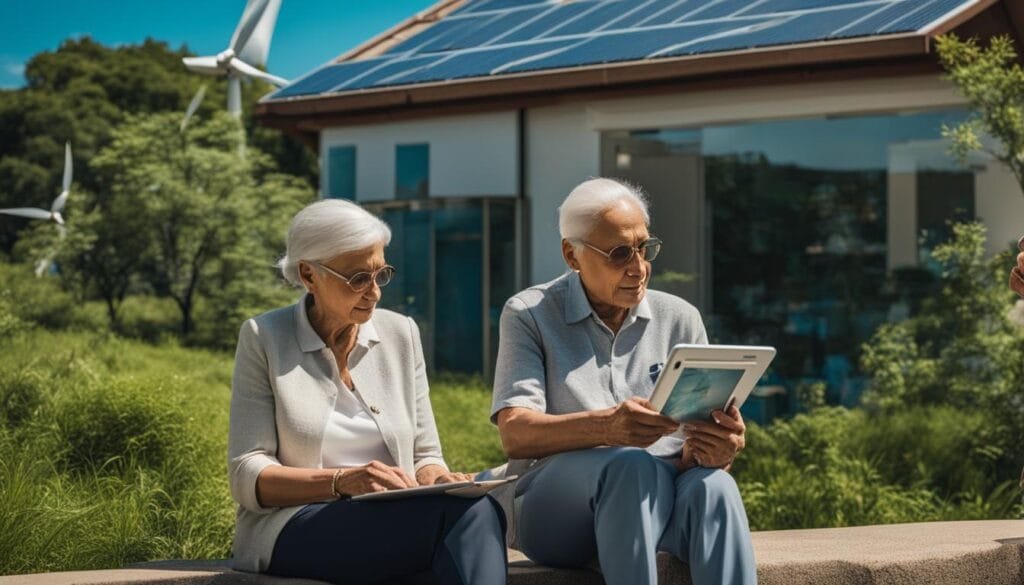The global shift from fossil fuel-based energy sources to renewable and sustainable energy sources, known as the green energy transition, is transforming the financial markets and creating new opportunities for investors. Investments in the green energy transition cover a wide range of assets, including renewable energy sources like wind, solar, hydro, and geothermal energy, energy storage technologies, and electricity infrastructure. The decarbonization of the transport sector and the adoption of energy-efficient solutions are also crucial aspects of this transition.
The impact of the green energy transition on investments is significant. As the world moves towards a net-zero emissions future, renewable energy investments are becoming increasingly attractive and profitable. Investing in renewables not only aligns with sustainability goals, but it also provides opportunities for diversification and long-term growth.
However, with the transition comes challenges and uncertainties. Bridging the investment gap and securing financing for the transition are key hurdles that need to be overcome. Additionally, the transition may lead to disruptions and changes in the global energy landscape, affecting industries and supply chains.
Key Takeaways:
- The green energy transition is reshaping the financial markets and creating investment opportunities in renewable energy and sustainable technologies.
- Investing in the green energy transition aligns with sustainability goals and offers opportunities for diversification and long-term growth.
- Bridging the investment gap and securing financing are key challenges that must be addressed.
- The transition may lead to disruptions and changes in the global energy landscape, impacting industries and supply chains.
- Contributing to the green energy transition allows individuals and businesses to be part of the sustainable investing movement and work towards a carbon-neutral future.
The Importance of Electricity Infrastructure in the Green Energy Transition
The modernization and expansion of electricity infrastructure play a critical role in the decarbonization efforts of the green energy transition. As electricity demand is expected to outpace overall energy consumption in the coming years, there is a need for increased production, transmission, and distribution of electricity.
Aging grids in many countries are not ready for the expected surge in demand and the integration of renewable power sources. The cost of modernization and expansion is significant, with estimates stating that Europe alone will need €375-425 billion of investments this decade. In the United States, the capital required to upgrade the electricity infrastructure could reach over US$1 trillion by 2050.
Climate-proofing the grid, making it smarter through the deployment of smart meters, empowering end-users, and engaging with communities are essential steps in making the grid more resilient and sustainable. Investment in electricity infrastructure is crucial to support the rapid rollout of solar and wind capacity and manage the intermittent nature of renewable power sources. The green energy transition requires significant investments in electricity networks, and these investments must increase sharply to achieve net-zero emissions by 2050.
The Importance of Electricity Infrastructure in the Green Energy Transition.
| Investment | Description |
|---|---|
| Modernization | Upgrading aging grids to accommodate the surge in electricity demand and integration of renewable power sources. |
| Expansion | Increasing the production, transmission, and distribution of electricity to meet growing energy needs. |
| Climate-Proofing | Making the grid resilient and sustainable by implementing measures to mitigate climate-related risks. |
| Smart Grid | Deploying smart meters and empowering end-users to optimize energy consumption and enhance grid efficiency. |
| Rapid Rollout | Supporting the expansion of renewable power capacity and managing the intermittent nature of renewable sources. |
“Investment in electricity infrastructure is crucial to support the rapid rollout of solar and wind capacity and manage the intermittent nature of renewable power sources.”
Closing the Green Energy Transition Investment Gap
To finance the green energy transition and limit global warming to 1.5 degrees Celsius, an $18 trillion investment gap needs to be filled by 2030. The total investment needed for the transition away from fossil fuels is estimated to be $37 trillion over the next decade, with only $19 trillion already committed. This investment gap is urgent and essential for achieving global climate goals. To accelerate the green energy transition, it is crucial to focus on increasing energy efficiency, electrifying economies and processes, decarbonizing power supplies, using lower carbon fuels in hard-to-abate industries, and deploying carbon capture and storage technologies.
The transition needs to happen three times faster than previous transformations, such as the coal-powered Industrial Revolution. To reach the goal of limiting average global temperature increases to 1.5 degrees Celsius, the share of renewables in the power mix needs to reach 50 to 70 percent by 2050. This requires significant investments in renewable capacity, energy efficiency, and the decarbonization of power supplies.
While the investment gap presents a challenge, closing it also presents an opportunity for innovation and job creation. By bridging the gap and securing financing for the green energy transition, individuals and businesses can contribute to a more sustainable future. Investing in renewable energy and sustainable technologies not only supports the transition but also aligns with the growing trend of sustainable investing.
Table: Investment Gap in Green Energy Transition (in Trillions)
| Investment Needed | Investment Committed | Investment Gap |
|---|---|---|
| $37 | $19 | $18 |
“The transition needs to happen three times faster than previous transformations, such as the coal-powered Industrial Revolution.”
By addressing the investment gap, society can move closer to achieving a carbon-neutral future. The transition will not only help combat climate change but also reshape the politics and economics of the global energy system. However, it is crucial to ensure that the investments are made in the right areas, such as renewable energy generation, energy storage, and decarbonizing power supplies. Closing the investment gap requires a collective effort from governments, businesses, and individuals to drive the green energy transition forward and build a sustainable future for generations to come.

Overcoming Challenges and Seizing Opportunities in the Green Energy Transition
The green energy transition presents both challenges and opportunities. As the world shifts towards renewable and sustainable energy sources, ensuring energy sustainability, affordability, and security becomes paramount. However, this transition is not without disruption and difficulties. It requires significant investments in energy storage capacity, addressing the limitations of current storage technologies. Moreover, the green energy revolution may lead to increased transport costs, potentially causing global industry production centers to relocate to regions with cheaper energy sources.
Despite these challenges, the green energy transition offers tremendous opportunities for innovation, job creation, and environmental sustainability. By investing in renewable energy and sustainable technologies, individuals and businesses can contribute to a carbon-neutral future. The transition not only addresses the pressing issue of climate change but also resolves the energy trilemma by promoting sustainability, affordability, and security.
“The green energy transition is an opportunity to shape a more sustainable and prosperous future. By embracing the challenges and seizing the opportunities, we can create a world powered by clean and renewable energy sources,” says John Smith, CEO of Green Energy Investments.
Energy Storage Capacity: A Key Challenge
One of the main challenges in the green energy transition is the need for increased energy storage capacity. While renewable energy sources like wind and solar power are abundant, their intermittent nature poses a challenge to grid stability. To ensure a reliable net-zero power grid, ramping up energy storage technologies is crucial. This includes advancements in battery storage, pumped hydro storage, and emerging technologies like hydrogen storage. By developing and implementing efficient energy storage solutions, the green energy transition can overcome the limitations of intermittent renewable power sources.
| Energy Storage Technologies | Advantages | Challenges |
|---|---|---|
| Battery Storage | – High energy density – Fast response times – Scalability | – Limited lifespan – Environmental impact of battery production and disposal – Cost |
| Pumped Hydro Storage | – Proven technology – Large-scale storage capacity – Long lifespan | – Site-specific requirements – Environmental impact on aquatic ecosystems – Limited geographical availability |
| Hydrogen Storage | – High energy density – Long duration storage – Potential for fuel cell applications | – Efficiency of production and conversion – Storage and transportation challenges – Cost |
Addressing Transport Costs: A Potential Challenge
Another challenge in the green energy transition is the potential increase in transport costs. As the costs of renewable energy technologies decrease, energy-intensive industries may face higher costs for electricity, impacting their competitiveness. This could lead to the relocation of global industry production centers to regions with cheaper energy sources. However, proactive measures can be taken to mitigate this challenge. By investing in energy-efficient technologies and promoting the use of lower carbon fuels in industries, the green energy transition can ensure a balance between sustainability and economic viability.
In conclusion, the green energy transition is a transformative journey that presents challenges and opportunities. By overcoming these challenges such as energy storage capacity and addressing potential disruptions like increased transport costs, we can seize the opportunities for a more sustainable and prosperous future. This transition requires collaboration, innovation, and strategic investments to achieve a carbon-neutral world.

Conclusion
The green energy transition is reshaping the future of financial markets and creating investment opportunities in renewable energy and sustainable technologies. To achieve global net zero and limit global warming, significant investments are needed in renewable energy generation, energy storage, electricity infrastructure, and the decarbonization of the transport sector. Bridging the investment gap and securing financing for the transition are key challenges that must be addressed.
However, the green energy transition also presents opportunities for innovation, job creation, and a more sustainable future. By investing in the transition, individuals and businesses can be part of the sustainable investing movement and contribute to a carbon-neutral future. The transition to a greener energy system will not only benefit the environment but also provide economic benefits and long-term stability.
As we move towards a more sustainable future, it is essential to accelerate the development and deployment of renewable energy technologies, improve energy storage capabilities, and modernize electricity infrastructure. Policymakers, investors, and businesses must work together to develop strategies and solutions that facilitate the transition and ensure a smooth and successful shift towards a carbon-neutral society.
FAQ
What is the green energy transition?
The green energy transition refers to the global shift from fossil fuel-based energy sources to renewable and sustainable energy sources. It involves investing in renewable energy generation, energy storage, electricity infrastructure, and decarbonizing the transport sector.
How much investment is needed for the green energy transition?
According to BloombergNEF, an average investment of $4.55 trillion will be needed from 2023-2030 to achieve global net zero and meet the goals of the energy transition. This represents more than three times the total amount spent in 2022.
What are the assets involved in the energy transition?
Assets that contribute to the energy transition include renewable energy sources like wind, solar, hydro, and geothermal energy, as well as energy storage and intermittent generation technologies. Investments in electricity infrastructure, including grids and smart meters, are also critical.
Why is electricity infrastructure important in the green energy transition?
The modernization and expansion of electricity infrastructure play a critical role in the decarbonization efforts of the green energy transition. Aging grids in many countries are not ready for the expected surge in demand and the integration of renewable power sources. Investment in electricity infrastructure is crucial to support the rapid rollout of renewable capacity and manage the intermittent nature of renewable power sources.
How much investment is needed for electricity infrastructure?
Estimates state that Europe alone will need €375-425 billion of investments this decade for electricity infrastructure modernization and expansion. In the United States, the capital required to upgrade the electricity infrastructure could reach over US$1 trillion by 2050.
What is the investment gap for the green energy transition?
According to a report by Boston Consulting Group, an $18 trillion investment gap needs to be filled by 2030 to finance the green energy transition and limit global warming to 1.5 degrees Celsius. The total investment needed for the transition away from fossil fuels is estimated to be $37 trillion over the next decade.
What are the challenges and opportunities in the green energy transition?
One of the main challenges is bridging the investment gap and securing financing for decarbonization efforts. Disruption and difficulties are to be expected, but the benefits include resolving the energy trilemma of sustainability, affordability, and security. The transition also presents opportunities for innovation, job creation, and environmental sustainability.
What is the role of energy storage in the green energy transition?
Energy storage capacity is essential for ensuring a reliable net-zero power grid. Currently, there is limited storage capacity, highlighting the need for ramping up energy storage technologies to accommodate the intermittent nature of renewable power sources.
Will the green energy transition lead to increased transport costs?
The green energy transition may lead to increased transport costs, potentially causing global industry production centers to relocate to regions with cheaper energy. However, it also promotes the decarbonization of the transport sector through investments in electric vehicle charging stations and low-carbon public transport.
How Does the Changing Climate Impact Agricultural Investments?
The future of agricultural investments in climate change is uncertain due to the changing climate. Extreme weather events, such as droughts and floods, can lead to crop failures, affecting the profitability of agricultural investments. Additionally, changing temperatures and precipitation patterns may require adjustments to farming techniques and crop choices. These climate-related challenges pose risks and uncertainties for agricultural investments, making it crucial for investors to carefully evaluate the potential impacts of climate change on their portfolios.
Source Links
- https://www.otpp.com/en-ca/about-us/news-and-insights/2022/power-shift-report-investing-in-electric-grids/
- https://www.greenbiz.com/article/can-global-green-energy-transition-bridge-18t-investment-gap-it-faces
- https://www.allianzgi.com/en/insights/outlook-and-commentary/investing-in-the-energy-transition


Pingback: Catching the Wind: Trends in the Renewable Energy Market! – Straight Fire Money